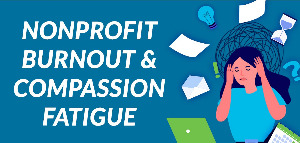
Working on a team requires more than just hard work, morale amongst co-workers, and willingness to work with others. The most important yet often ignored that attributes to a team’s success is effective communication. Communication is a vital part of any business environment—especially a nonprofit organization since many employees wear multiple hats—as it facilitates a consistent flow of information. When it comes to team communication, the purpose of interacting among co-workers is to share information that is essential to achieving organization goals. In addition, good communication makes it easy for team members to coordinate with one another effectively.
An organization’s communication strategy usually consists of techniques that encourage open communication and effective teamwork in a workplace environment. Having an action plan in place for your organization can help to improve your communication skills, work on team building, and executive tasks efficiently. This kind of proactive leadership is even more important today, given the rise of remote teams and virtual collaboration.
Here’s just a few of the many benefits that result from an effective communication strategy:
1) Supports Employee Engagement: Effective communication in the workplace increases employee morale and engagement by helping team members feel connected to the work they’re doing and the organization their working for. Thoughtful team-building activities can also help nurture communication skills, which improves camaraderie and employee engagement. Increasing employee engagement can lead to reduced turnover, a better customer experience, and even increased profitability
2) Helps with Productivity: Inefficient work habits or missed project deadlines are almost always the result of poor workplace communication skills. By using effective communication strategies, you can be clearer about expectations and ultimately get the results you need to deliver projects in a timely manner.
3) Opens Up Doors for Innovation Opportunities: An environment of open communication in the workplace fosters creative problem solving, more adventurous ideas, and out-of-the-box thinking. It helps you create space for innovation by fostering a “no bad ideas” attitude and encouraging your team to try new things—even if those projects don’t work out as anticipated. Making space to learn from different collaboration styles can really expand the possibilities for your organization.
Effective communication in the workplace might sound straightforward but it’s about so much more than having a simple conversation—especially when not everyone communicates the same way. You need to be intentional and use the right strategies that provide diverse opportunities for both formal and informal communications across the organization. By employing communications strategies that foster open communication and collaboration, you can build an organization full of employees who are engaged, efficient, and innovative. And that’s the kind of team that makes an organization successful and most importantly, support the communities you serve.

Nonprofit workers strive to make the world a better place. However, these passionate professionals often face long working hours, limited resources, funding deficiencies and an unrelenting stream of other on-the-job challenges. All this and more can lead to employee burnout, as well as nonprofit compassion fatigue.
How can nonprofit employees of all levels better address such difficulties and avoid becoming overly strained? Below are some actionable ideas to help prevent employee burnout and work toward a healthier work-life balance.
First, what is nonprofit compassion fatigue and what does it look like? Referred to at times as secondary trauma or vicarious trauma, compassion fatigue is a way to describe the excessive stress affecting those exposed to the traumatic suffering of others leading to desensitization, indifference or apathy. When untreated, it could lead to exhaustion, irritability, reduced productivity and absenteeism, along with physical and mental health problems.
Essentially, compassion fatigue means that a person working continuously under strenuous conditions no longer feels able to care about the people they serve. Often, these individuals get to this point by minimizing their own suffering. In fact, industry reports have found that 62% of people who engage in emotional work tend to hide their personal feelings. Combine this with being buried in work and these people can easily develop feelings of helplessness and hopelessness.
Over time, this not only affects an employee’s health and relationships, but it can significantly impact employee retention. A 2021 study found that 69% of participants believe their organizations are understaffed. Chronic staffing issues ultimately whittle away at a nonprofit’s ability to achieve objectives.
What can leaders and HR professionals do to address compassion fatigue and burnout? It starts by implementing a strategy designed to promote a healthy work culture. Everyone should be encouraged to capitalize on vacation time, lunch breaks and time off-the-clock to de-stress from the important work they are striving to accomplish. Leaders should also establish and enforce reasonable work hours.
Another way to help address arduous workloads is to create a prioritization system for projects and tasks. While the job market is understandably in flux, efforts should be made to hire more staff or recruit additional volunteer support.
Lastly, open the door to enhanced communication strategies. Extend genuine thanks to the staff and encourage honest feedback, anonymous or otherwise. Not only are these methods more sustainable, but, in the end, they can generate greater employee engagement, retention and job satisfaction.
For employees, to avoid becoming burnt out and feeling powerless, it’s advised to utilize vacation time and take regular breaks. By “unplugging” during the day — even if it’s only a short break — it’s possible to reduce stress, gain perspective and feel more in control. Also, learn to say “no” without feeling guilty. Setting clear boundaries on messaging after hours, task delegation and more could do wonders for future productivity.
To learn more about combating nonprofit employee burnout, please see the accompanying resource.
Resources:
https://www.qgiv.com/blog/how-to-overcome-nonprofit-burnout-and-compassion-fatigue/
https://www.keela.co/blog/nonprofit-resources/3-leading-causes-of-nonprofit-burnout
https://www.idealist.org/en/careers/recognizing-compassion-fatigue-helping-professions

Here at UST, we aim to create content designed to educate 501(c)(3) nonprofit leaders and strengthen the nonprofit sector. As part of our on-going commitment to serve nonprofit organizations, UST has published two on-demand webinars on relevant topics important to the sector. For just $29, you can register to watch one of our on-demand webinars to discover nonprofit strategies and best practice tips. PLUS, with your registration, you’ll also receive essential handouts for nonprofit leaders.
Human Resource Strategies: Employee Engagement and Nonprofit Brand
Today’s increasingly virtual landscape—along with the workforce’s evolving strategic priorities—has not only changed how we work, but it’s also impacted the way we interact with one another. To maintain positive morale and strengthen company culture, nonprofit leaders must prioritize employee engagement and brand reputation strategies. During this on-demand webinar, discover helpful tactics for building a string nonprofit brand while fostering on engaged workforce. Register here.
The Workplace of Today and Tomorrow Managing Risk and Reward
During the last few years, nonprofits around the globe have been forced to develop contingency plans and re-examine the nature of ‘essential’ services. Learn how to identify (and mitigate) nonprofit risk while fostering an engaged workforce. During this on-demand webinar, you’ll learn how to identify (and mitigate) nonprofit risk while fostering an engaged workforce. You’ll also be able to download several handouts essential for managing risk at your nonprofit. Register here.

In the latest rendition of UST Live, we were joined by thought leaders from across the U.S. with expertise in nonprofit advocacy. Guest moderator, Chai Jindasurat of Nonprofit New York, lead the conversation as the group discussed how advocacy efforts have changed and shared what their nonprofit organizations are doing to ensure they’re being heard at the local, state, and federal levels.
You’ll also hear where they see cross-sector advocacy aligning in the next 12-18 months and what you can do to capture the attention of legislators to effect change—plus much more.
Watch now to discover:
Upcoming UST Live Webinars: This webinar series was designed to equip nonprofits with the strategies and resources they need to survive (and thrive) in a constantly evolving environment. Be on the lookout for future UST Live sessions—scheduled for May, August, and November.

The grantmaking process is often exclusive and expensive, making it accessible to those select nonprofits with the right expertise and networks, which can be costly for organizations and funders to seek and distribute funding. Applying for grants is a tedious and expensive process, with a good percentage of applications taking upwards to a week or more just to write. To help those communities who’ve been commonly excluded to thrive, organizations with access to capital need to start adopting more equitable grantmaking practices—making funding more accessible to everyone. Grantmakers have a responsibility to create equitable processes, making sure that communities of color and other marginalized populations are not adversely impacted by giving practices.
When looking at grantmaking, diversity includes casting a wide net to attract diverse applicants. Inclusion might mean your reviewers are diverse, mirroring the community the organization serves. Equity might include revamping the application process making it more accessible.
In following these four tips, nonprofit organizations will be more equipped to have the right processes in place to evaluate equitable grantmaking:
1) Create a More Diverse Pool of Applicants: The first step toward equitable grantmaking is to encourage a diverse applicant pool. If nonprofits serving marginalized communities don’t know about your funding, they won’t be able to apply. Examine your pipeline to determine if you’re casting a wide net outside of your familiar go-to organizations. Look into expanding your networks—we all have a tendency to build relationships with those like ourselves. Attend diverse community meetings, events, or town halls to promote your fund.
2) Keep the Entire Application Process Simple: Grant applications can feel complicated to newer applicants. Use clear, simple language when creating instructions and applications. The general rule is to write at an eighth-grade reading level. (Word offers this functionality–you can use google to find out how to use it). When it comes to equitable grantmaking, ADA-friendly applications are a must. For example, screen reader capability and keyboard accessibility create an equitable website experience. Without these, applicants with disabilities may have difficulty applying.
3) Lower Chances of Bias in Review Process: Implicit bias is an unconscious association made about social groups. For example, many automatically assume business executives are male and secretaries are female. While it is ingrained in us from a young age, implicit bias can hinder best intentions for equitable grantmaking. By creating an unbiased review process, you’ll strengthen the entirety of the grant review process. Some examples include, offer implicit bias training to your reviewers and examine reasons why applicants were rejected.
4) Review Reporting Metrics: Metrics are vital to any funder’s success—including equitable giving outcomes. Be sure to create equity metrics early in the process. You’ll want to track data points such as the number of diverse applicants and awardees.
To reduce funding barriers, make sure to take a closer look at your processes from beginning to end. Take a look at each step and try to pin-point when diverse populations are no longer in the forefront. Be open to outside perspectives who could provide unique solutions—grantees and reviewers could offer ideas around inclusivity and/or equity.

Today’s increasingly virtual landscape—along with the workforce’s evolving strategic priorities—has not only changed how we work, but it’s also impacted the way we interact with one another. Employee engagement practices are an essential part of any organization—they can save the company money, improve productivity, increase morale, and decrease turnover. To maintain positive morale and strengthen company culture, nonprofit leaders must prioritize employee engagement and brand reputation strategies.
For just $29 you can discover helpful tactics for building a strong nonprofit brand while fostering an engaged workforce. During this on-demand webinar, you’ll learn:
Register today and you’ll also receive essential handouts for nonprofit leaders—including an employee engagement checklist, a comprehensive onboarding plan as well as creative ideas for celebrating your team and more—FREE with your registration.

Members are a vital key to success when sustaining and growing your association and retaining those members ensures a long-term survival of your nonprofit organization. While recruiting and enrolling new members is important for growth, making a conscience effort to retain members is equally as important. Making your current members feel important and special, reminds them of why they joined your association in the first place. Some tried and true retention methods include creating specialized resources, and educational content—the more you publish industry reports, educational webinars, or offer member discounts, the happier your members will be.
The best course of action to take when retaining members include, focusing on their needs, remind them how much value they bring to your association and engaging them on a regular basis. We’ve put together a list of 5 best practices for improving member retention at your nonprofit organization:
1) Create an Onboarding Plan: First-time members are a specific group within your membership profile that need to be approached with specific strategies. Look for ways to keep new members engaged—monthly check-ins, education materials about new products, keep them informed about upcoming events like webinars or virtual conferences—give them opportunities to learn more about the work your organization is doing in the nonprofit sector.
2) Offering Member Only Benefits: Members are interested and/or passionate about your cause, and they want to feel like they’re making a difference. Communicate with them often with weekly or monthly newsletters as well as through social media. Provide perks such as exclusive, member-only offers from your partners as well as networking opportunities. If possible, provide educational opportunities such as webinars, workshops, and relevant eBooks at member-only prices.
3) Create a Community for Your Members: Encourage a thriving, engaged community of like-minded individuals. Such as, organizing/hosting more networking events, mentorship programs, and creating an online member directory—all methods that can help to increase member retention.
4) Remind Members of the Value You Offer: In your end-of-year communications to members, remind them how their membership with your organization has benefited their association over the past year and how much value their membership brings to your organization.
5) Ask Members to Complete an Exit Survey: While it’s not ideal, it is the reality that there will be members who will choose to cancel their membership. This is a great opportunity to capture unique insight into why a member is leaving by asking them to fill out an exit survey. The data acquired can bring light to pitfalls or areas of your organization to be reviewed and improved upon.
Member retention isn’t just a one-time activity. It is something that’s kept in mind throughout the whole member lifecycle—it’s a strategy that requires just as much attention as recruiting new members. To keep members around long-term, you should be focusing on building better relationships with your members from day one.

Nonprofit managers are relied upon to not only lead productive teams, hold employees accountable, and manage processes but are also expected to engage and motivate employees with limited funding. They must be innovative, resourceful, and strategic. To help nonprofit leaders maintain high-performing teams—while also strengthening their leadership skills—we created the 2021 Nonprofit Leadership Toolkit.
This free toolkit includes a performance appraisal checklist, manager-employee check-in form, tips for leading a hybrid workforce, and more:
Want access to more HR-specific articles, templates and checklists? Sign up for a FREE 60-Day Trial of UST HR Workplace today! You’ll also gain access to live HR certified consultants, 300+ on-demand training courses and an extensive compliance library.

Whether you’re aspiring to be an executive leader, get promoted into a director’s position, or even launch your own nonprofit—rarely there are clearly defined paths to career development when working in the nonprofit sector. While this lack of structure can be challenging, it offers an unexpected opportunity to pave or create your own career path. Without the typical career ladder to climb, the opportunity to take on new responsibilities could be presented to you in a more timely fashion. At any age, with drive, desire and expertise being essential characteristics, you can become a nonprofit leader who wants to make a difference.
In order to create the right professional development plan, here are nine methods to follow, to consider, and use as a guide when furthering ones’ professional career as a nonprofit leader:
1) Conduct thorough interviews: Find those who hold a position that you might aspire to want one day. Take the opportunity to ask questions about how they got to where they are, what their day-to-day tasks look like, how they contribute to the organization, and what the position requires of them.
2) Seek out volunteer opportunities: When it comes to learning, especially within the nonprofit sector, there’s no substitute for hands-on experience. Volunteering can offer exposure to the operational facets of the organization by taking on new responsibilities, such as, join the fundraising or strategic planning committee or volunteer to help with the organization’s next event.
3) Ongoing education: If you’re looking for an advantage when pursuing leadership opportunities, consider looking into continuing education (i.e.: an advanced degree, or a specific leadership training program). Having this additional training under your belt will set you apart being well versed in business management principles and the ability to juggle competing priorities.
4) Learn about your organization: Take the time to develop a well-rounded view of everything that is involved in the role of running a nonprofit. This experience will be valuable to you as you progress into a leadership position.
5) Apply constructive feedback: As you take on new challenges and work outside your comfort zone, it’s more than likely you’ll make mistakes along the way. Take the time to learn from these and plan how you will do better in the future.
6) Network amongst your peers: Find people who are at a similar point in their own careers and develop genuine relationships with them. Be sure that you add real value to the relationship and that way, your peers will come to value you—opening doors for you in the future.
7) Relocate to another organization: With a strong foundation of skills in place and a desire to take on more responsibility, you might find that your current organization doesn’t have any openings for you to move up to. Take this opportunity to look for other employment and if you find a great position within your network, don’t hesitate to pursue it.
8) Join a nonprofit board: Being part of a board will give you high-level insights about the inner workings of nonprofits. Develop relationships with others who serve on nonprofit boards and seek out an organization doing work/serving a community that you’re passionate about.
9) Find day-to-day challenges: Leaders face challenges daily, so it is crucial to avoid becoming complacent. Striving to challenge yourself on a daily basis will not only push you to find solutions, it will help you build your resume.
When applying these methods, you will develop the skills and knowledge necessary to successfully lead an organization. If you envision yourself in a leadership role, you’ll have the ability to lay the foundation by excelling in the position you currently hold. These methods will help you cultivate leadership skills, emphasize teamwork and inclusive decision-making.

A strong leadership team is vital to the success of any nonprofit organization—without it you risk reduced productivity, delayed decisions, and low morale. Rooted in the ability of a nonprofit to maintain sustainability, having a leadership succession plan in place is vital to organizational success.
Don’t miss your chance to download a free copy of UST’s latest Employer Guide, 3 Vital Steps for Developing a Durable Nonprofit Leadership Team, to discover strategies that can help identify (and develop) tomorrow’s leaders with training opportunities designed to strengthen your brand and build resilient teams. In this eBook, you’ll discover:
The consequences of insufficient leadership can be devastating to an organization. Safeguard your nonprofit and its mission by reinventing your organizational leadership strategy—minimizing the threat (and high cost) of turnover.

UST maintains a secure site. This means that information we obtain from you in the process of enrolling is protected and cannot be viewed by others. Information about your agency is provided to our various service providers once you enroll in UST for the purpose of providing you with the best possible service. Your information will never be sold or rented to other entities that are not affiliated with UST. Agencies that are actively enrolled in UST are listed for review by other agencies, UST’s sponsors and potential participants, but no information specific to your agency can be reviewed by anyone not affiliated with UST and not otherwise engaged in providing services to you except as required by law or valid legal process.
Your use of this site and the provision of basic information constitute your consent for UST to use the information supplied.
UST may collect generic information about overall website traffic, and use other analytical information and tools to help us improve our website and provide the best possible information and service. As you browse UST’s website, cookies may also be placed on your computer so that we can better understand what information our visitors are most interested in, and to help direct you to other relevant information. These cookies do not collect personal information such as your name, email, postal address or phone number. To opt out of some of these cookies, click here. If you are a Twitter user, and prefer not to have Twitter ad content tailored to you, learn more here.
Further, our website may contain links to other sites. Anytime you connect to another website, their respective privacy policy will apply and UST is not responsible for the privacy practices of others.
This Privacy Policy and the Terms of Use for our site is subject to change.
UST maintains a secure site. This means that information we obtain from you in the process of enrolling is protected and cannot be viewed by others. Information about your agency is provided to our various service providers once you enroll in UST for the purpose of providing you with the best possible service. Your information will never be sold or rented to other entities that are not affiliated with UST. Agencies that are actively enrolled in UST are listed for review by other agencies, UST’s sponsors and potential participants, but no information specific to your agency can be reviewed by anyone not affiliated with UST and not otherwise engaged in providing services to you except as required by law or valid legal process.
Your use of this site and the provision of basic information constitute your consent for UST to use the information supplied.
UST may collect generic information about overall website traffic, and use other analytical information and tools to help us improve our website and provide the best possible information and service. As you browse UST’s website, cookies may also be placed on your computer so that we can better understand what information our visitors are most interested in, and to help direct you to other relevant information. These cookies do not collect personal information such as your name, email, postal address or phone number. To opt out of some of these cookies, click here. If you are a Twitter user, and prefer not to have Twitter ad content tailored to you, learn more here.
Further, our website may contain links to other sites. Anytime you connect to another website, their respective privacy policy will apply and UST is not responsible for the privacy practices of others.
This Privacy Policy and the Terms of Use for our site is subject to change.